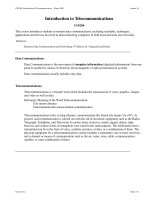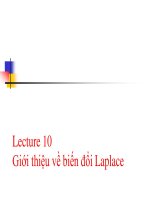Lecture no09 unconventional equivalence calculations
Bạn đang xem bản rút gọn của tài liệu. Xem và tải ngay bản đầy đủ của tài liệu tại đây (621.83 KB, 17 trang )
Irregular Payment Series and
Unconventional Equivalence Calculations
Lecture No. 9
Chapter 3
Contemporary Engineering Economics
Copyright © 2016
Contemporary Engineering Economics, 6 th edition
Park
Copyright © 2016 by Pearson Education, Inc.
All Rights Reserved
Example 3.23: Uneven Payment Series
How much do you
need to deposit today
(P) to withdraw $25,000
at n = 1, $3,000 at n = 2,
and $5,000 at n = 4, if
your account earns 10%
annual interest?
$25,000
$3,000
$5,000
0
1
2
3
4
P
Contemporary Engineering Economics, 6 th edition
Park
Copyright © 2016 by Pearson Education, Inc.
All Rights Reserved
Check to see if $28,622 is indeed
sufficient.
0
1
2
3
4
Beginning
Balance
0
28,622
6,484.20
4,132.62
4,545.88
Interest
Earned
(10%)
0
2,862
648.42
413.26
454.59
Payment
+28,622
−25,000
−3,000
0
−5,000
Ending
Balance
$28,622
6,484.20
4,132.62
4,545.88
0.47
Rounding error.
It should be “0.”
Contemporary Engineering Economics, 6 th edition
Park
Copyright © 2016 by Pearson Education, Inc.
All Rights Reserved
Example 3.25: Future Value of an Uneven
Series with Varying Interest Rates
Given: Deposit series as given over 5 years
Find: Balance at the end of year 5
Contemporary Engineering Economics, 6 th edition
Park
Copyright © 2016 by Pearson Education, Inc.
All Rights Reserved
Solution
Contemporary Engineering Economics, 6 th edition
Park
Copyright © 2016 by Pearson Education, Inc.
All Rights Reserved
Composite Cash Flows
Situation 1: If you make
4 annual deposits of $100
in your savings account,
which earns 10% annual
interest, what equal
annual amount (A) can be
withdrawn over 4
subsequent years?
Situation 2: What value
of A would make the two
cash flow transactions
equivalent if i = 10%?
Contemporary Engineering Economics, 6 th edition
Park
Copyright © 2016 by Pearson Education, Inc.
All Rights Reserved
Establishing Economic Equivalence
Method 1: At n = 0
Contemporary Engineering Economics, 6 th edition
Park
Method 2: At n = 4
Copyright © 2016 by Pearson Education, Inc.
All Rights Reserved
Example 3.26: Cash Flows with Sub-patterns
Given: Two cash flow transactions, and i =
12%
Find: C
Contemporary Engineering Economics, 6 th edition
Park
Copyright © 2016 by Pearson Education, Inc.
All Rights Reserved
Solution
Strategy: First select the
base period to use in
calculating the equivalent
value for each cash flow
series (say, n = 0). You can
choose any period as your
base period.
Contemporary Engineering Economics, 6 th edition
Park
Copyright © 2016 by Pearson Education, Inc.
All Rights Reserved
Example 3.27: Establishing a College Fund
Given: Annual college expenses = $40,000 a year
for 4 years, i = 7%, and N = 18 years
Find: Required annual contribution (X)
Contemporary Engineering Economics, 6 th edition
Park
Copyright © 2016 by Pearson Education, Inc.
All Rights Reserved
Solution
Strategy: It
would be
computationally
efficient if you
chose n = 18 (the
year she goes to
college) as the
base period.
Contemporary Engineering Economics, 6 th edition
Park
Copyright © 2016 by Pearson Education, Inc.
All Rights Reserved
Cash Flows with Missing Payments
Given: Cash flow series with a missing payment, i = 10%
Find: P
Contemporary Engineering Economics, 6 th edition
Park
Copyright © 2016 by Pearson Education, Inc.
All Rights Reserved
Solution
Strategy: Pretend that we
have the 10th missing
payment so that we have a
standard uniform series. This
allows us to use (P/A,10%,15)
to find P. Then, we make an
adjustment to this P by
subtracting the equivalent
amount added in the 10th
period.
Contemporary Engineering Economics, 6 th edition
Park
Copyright © 2016 by Pearson Education, Inc.
All Rights Reserved
Example 3.28: Calculating an Unknown Interest
Rate
Given: Two payment options
o Option 1: Take a lump sum payment in the amount of $192,373,928.
o Option 2: Take the 30-installment option ($9,791,667 a year).
Find: i at which the two options are equivalent
Contemporary Engineering Economics, 6 th edition
Park
Copyright © 2016 by Pearson Education, Inc.
All Rights Reserved
Solution
$192,373,928 $9,791,667(P / A, i ,30)
(P / A, i ,30) 22.3965
Excel Solution:
Contemporary Engineering Economics, 6th
Contemporary Engineering Economics, 6 th edition
edition, ©2015
Park
Copyright © 2016 by Pearson
15Education, Inc.
All Rights Reserved
Example 3.29: Unconventional Regularity in
Cash Flow Pattern
Given: Payment series given, i = 10%, and N =
12 years
Find: P
Contemporary Engineering Economics, 6 th edition
Park
Copyright © 2016 by Pearson Education, Inc.
All Rights Reserved
Solution
Strategy: Since the cash
flows occur every other year,
find out the equivalent
compound interest rate that
covers the two-year period.
• Equivalence Calculations for a
Skipping Cash Flow Pattern
Solution
Actually, the $10,000 payment occurs every other year
for 12 years at 10%.
We can view this same cash flow series as having a
$10,000 payment that occurs every period
at an interest rate of 21% over 6 years.
Contemporary Engineering Economics, 6 th edition
Park
Copyright © 2016 by Pearson Education, Inc.
All Rights Reserved









